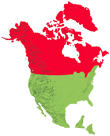DK People & Places: Canada, Alaska & Greenland
Northern North America is occupied by Canada, the second-largest country in the world, the US state of Alaska, and the Danish self-governing territory of Greenland. Much of Greenland is covered by ice, and all these regions are sparsely populated, although there are several large cities in Canada. These are mainly in the south of the country and on the Pacific coast near the stunning Rocky Mountains. Huge oil and mineral reserves have brought wealth to both Canada and Alaska.
Alaska was part of Russia until 1867, when it was sold to the US for $7.2 million. Most Americans thought this was a huge waste of money until gold was discovered there in 1896, attracting many people hoping to make their fortune. The discovery of oil in the Arctic Ocean in 1968 brought great wealth to the state, and tourism is also a major source of income.
The First Nations and the Inuit peoples lived in Canada long before Europeans began settling there in the 17th century. They number about 900,000 people, or 4 percent of the population, and have kept many of their traditional customs and traditions. In 1999, the self-governing Inuit homeland of Nunavut was created in northern Canada.
Greenland is the world’s largest island, but has a population of less than 60,000 because its climate is so harsh and cold. Most live in small settlements along the coast, making a living from catching fish, shrimp, and seals. There is a small network of roads, but dogsleds and planes are more reliable than cars for getting around.
Until the middle of the 18th century, large parts of eastern Canada were ruled by France, and many French people settled there, mainly in Quebec. Today, one-quarter of Canadians speak French as their first language. Canada is officially bilingual and recognizes both English and French as its official languages, but some French speakers in Quebec want to leave Canada and set up their own independent state.
One-third of Canada lies within the Arctic Circle, and much of the land is permanently frozen. Farming in the north is therefore impossible, and food supplies are flown in from outside. Houses are built on stilts above the snow, and pipes are heavily insulated against the cold. Farther south, large cities such as Montreal and Toronto have underground shopping centers so that shoppers can stay inside during winter.
Capital city: Juneau
Area: 570,374 sq miles (1,477,268 sq km)
Population: 640,000
Official state language: English
Major religion: Christian
Currency: US dollar
Capital city: Ottawa
Area: 3,851,788 sq miles (9,976,140 sq km)
Population: 31.4 million
Official languages: English and French
Major religion: Roman Catholic
Currency: Canadian dollar

